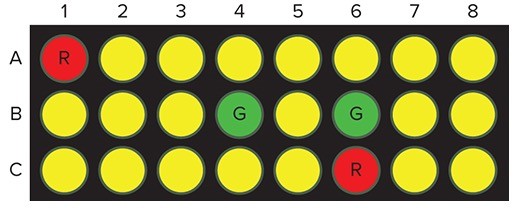You are working in a cancer lab and are interested in identifying some genes that are important in the onset of lung cancer. You have several genes you think may be involved, so you "print" spots of the candidate DNA sequences on a microarray slide. After doing this, you isolate mRNA from both normal lung cells and cancerous lung cells. You make fluorescently-tagged cDNA from each mRNA sample; the cDNAs from normal cells are tagged with a green-colored molecule and the cDNAs from cancer cells are tagged with a red-colored molecule. You hybridize the cDNAs with the microarray and get the following data. (Green spots are labeled with "G", red spots are labeled with "R".)
width="330" /> McGraw-Hill EducationWhich of the following spots represent DNA that you should study further as potentially having a role in lung cancer?
A. spots A1 and C6.
B. spots A1, B4, B6, and C6.
C. all spots except A1 and C6.
D. all spots except A1, B4, B6, and C6.
E. spots B4 and B6.
Answer: A
You might also like to view...
Nearly ALL cases of acute listeriosis require hospitalization
Indicate whether the statement is true or false.
Answer the following statements true (T) or false (F)
1.The zebra mussel and the gypsy moth both have reduced biodiversity in North America. 2.One important conservation tool used to restore native populations is to set aside an area and protect it from overexploitation, invasive species, and habitat destruction. 3.After nearing extinction in the 1960s, the bald eagle population is now about 10,000. 4.The greatest threat to the endangered great spotted kiwi of New Zealand is introduced predators. 5.Suspended matter that floats in the air, such as ash, soot, mold spores, and road dust, is known as particulates.
During mitosis, which of the following normally occurs?
a. Homologous chromosomes pair. b. Replicated chromosomes line up on the equatorial plate. c. Tetrads form. d. Unreplicated chromosomes become oriented in the center of the cell. e. Maternal and paternal chromatids pair.
Microscopic examination of a patient's fecal culture shows spiral bacteria. The bacteria probably belong to the genus
A) Campylobacter jejuni. B) Escherichia coli. C) Salmonella typhi. D) Shigella spp. E) Vibrio cholerae.